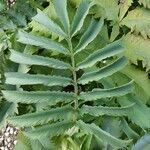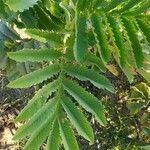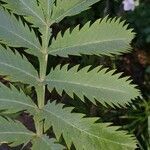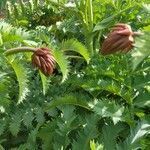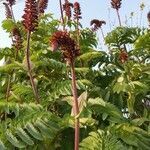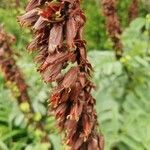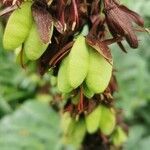Erect, sappy shrub to 3 m high, glaucous, glabrous; stems fleshy. Leaves imparipinnate, to 35 (–50) cm long, waxy-blue; leaflets (7) 9–13, lanceolate or lanceolate-oblong, deeply serrate, sometimes double-serrate, to 12 cm long, to 5 cm wide, green and glabrous on both surfaces; stipules fused into 1 above petiole, broadly lanceolate, to 10 cm long. Inflorescence a dense terminal pedunculate raceme, up to 40 (–70) cm long, sometimes longer. Flowers red-brown. Sepals unequal, the longest 2–2.5 cm long, the shortest (abaxial) one saccate or spurred. Petals 4, sometimes 5, unequal, shorter and narrower than sepals, shortly exserted each side of abaxial sepal, the apices ±rolled. Ovary 4-lobed; style c. equal to stamens. Capsule (2–) 3–4 cm long, deeply 4-lobed, membranous-papery, glabrous. Seeds 2 per locule, ovoid, c. 5–6 mm long, black, shiny.
A shrub. It grows 1.8-3 m high. It has hollow thick stems. They grow from ground level with a few side branches. The leaves are large and have leaflets along the stalk. The leaves are 50 cm long and with 17 oval leaflets. The flowers are dark brown. They are in long, erect stalks. The fruit are black.
